|
|
||||||||||||||||||||||||||||||||||||
Hardly Strictly Bluegrass Festival
|
|
|
|
Hardly Strictly Bluegrass
Festival
Hardly
Strictly fest is most definitely
wonderful By Grace
Sankey-Berman SAN
FRANCISCO—The Hardly Strictly Bluegrass Festival began 10 years ago when
billionaire Warren Hellman threw a birthday bash for his wife, an event
attended by an estimated 15,000-20,000 people. It went so well that he
decided to make it a free annual event for the public. An estimated
600,000 people attended this year’s festival, Oct. 1-3. It was my
first time at the festival, which is held at Golden Gate Park. Access to
the venue was easy with a variety of public transportation that takes
you right to the site. On opening day, armed with maps, programs and
lots of information provided by our good friend and great host Wade
Wright, my friends and I road a jam-packed bus to the park, where three
of the six stages were already set up and the festival was in full swing
with what seemed like an endless sea of people. The Meadows area
provided a beautiful setting with ample shade. With some
help from police officers and the very helpful information center, we
easily got our bearings and found a great spot at the Banjo stage, where
the Dukes of September Rhythm Revue featuring Donald Fagen, Michael
We were
lucky to find a picnic table about midway to the stage, where Rosanne
Cash was playing. She was not an exception—like most of the
The closing
act of the festival was headliners Sharon Jones and the Dap-Kings. Jones is
finally enjoying crossover success after years of hard work in the
music industry. For over a decade she worked as a backup singer and
Jones was
introduced as “The Fireball of Soul.” Most of the people were on their
feet even before she came on the stage and remained standing for the
Jones
successfully captured soul and funk music as it was back in the ’60s and
’70s, but still making it uniquely her own. I am grateful to Tom Ineck
for suggesting that I check out Sharon Jones and the Dap-Kings. It was
worth going to the festival just to discover this musical gem. Throughout
the festival I was impressed with the diversity of music and the caliber
of musicians who played to tens of thousands of appreciative fans at
each stage. The name of the event says it all: the Hardly Strictly
Bluegrass Festival featured country, jazz, blues, rap, and rock ‘n’
roll—with a wide range of acts that included the unconventional Patti
Smith, Emmylou Harris, Randy Newman, Elvis Costello, Lyle Lovett, the
Ebony Hillbillies, the sensational Sharon Jones and the Dap-Kings and
even MC Hammer.
The crowd
was friendly, eclectic and sometime colorful. From hippies to yuppies,
young and old people, families with kids and even pets, some dancing,
laughing, and sharing food and drinks. It was heart-warming to see
people share their space, their blankets and their chairs. Occasionally,
there was too much smoke in the air, but you could easily get away from
it if you wanted to. The
festival food was great, the kind of healthy fare you will find at a
farmers market. I had artichoke hearts with white sauce, crabmeat and
shrimp that was not like any typical festival food—fresh and delicious.
And if you didn’t want to buy from the vendors, you could bring your own
food and beverages, even alcohol. Go to the
festival early to find a good spot and stay at one stage. Because of the
large crowds, it takes too much time to move from one stage to another
and you miss out on great music in the process. There is so much great
music, but you can’t hear it all. And whatever stage you choose to stay
at, you will hear plenty of good music. Thanks to
Warren Hellman for giving the gift of great music to everyone. It was
also refreshing to not see any obvious business ads.
Photo Gallery
Faces of the Hardly Strictly Bluegrass Festival
Trumpeter
Bergeron dazzles audience of 600
By Tom
Ineck
In two
dynamic sets of high-note, high-speed virtuosity, he wowed the crowd
with his dazzling technique and a set of big-band charts that challenged
everyone in the 17-piece ensemble. From the downbeat of Allen Carter’s
“Ridin’ the ‘E’ Train,” Bergeron jumped in with the melody then soloed
in a cluster of bright high notes played with astounding power and
precision. A Bill Liston arrangement of “Waltz of the Flowers” turned
the classical “Nutcracker” favorite into a swinging jazz waltz,
featuring fellow Maynard Ferguson alumni Bergeron on trumpet and Matt
Wallace on tenor sax. “High
Clouds and a Chance of Wayne” is the comical title for a mid-tempo blues
composed for Bergeron by friend Tom Kubis. It began with five trumpets
wailing in a breathtaking soli passage and also featured Scott Vicroy on
baritone sax and Mark Benson on alto sax. Of course, Bergeron turned in
some stunning variations during his solo, ending the first set with a
typically grand flourish. On
Bergeron’s return to the stage in the second half of the show, he chose
another popular favorite, “Friend Like Me,” from the Disney movie
“Aladdin.” Originally arranged for trumpeter Arturo Sandoval, it
received a Latin treatment with a beat established by Tom Harvill’s
persistent piano riffing. Bergeron contributed another solo of
diamond-hard clarity, and other notable solos came from Wallace on tenor
and Todd Thatcher on trombone. A Tom Kubis
arrangement of “You Go to My Head” featured five flutes setting the mood
for Begeron’s mellow lead on flugelhorn, which he then alternated with
trumpet for a soli passage with the sax section as the tune accelerated.
After an incisive tenor sax solo by Paul Haar, Bergeron returned to the
theme on flugelhorn, traded to Haar for another statement, then came
back on trumpet for a mind-boggling, high-altitude cadenza. After a
brief respite while the NJO performed Benson’s bebop waltz “Donn Lee,”
the trumpeter returned for perhaps the most astonishing performance of
“Rhythm
Method,” another uptempo Kubis arrangement, had Bergeron essaying a
slightly more subdued sound using a Harmon mute. Ed Love on soprano sax
joined the trumpeter for a unison passage then soloed, followed by solos
from Bergeron and Haar on tenor sax. The band returned to the theme with
Bergeron on open horn joined by the saxes, leading to a fine drum solo
by Greg Ahl. The encore was a trumpet face-off between Bergeron and Bob
Krueger on the bluesy “Maynard & Waynard,” an obvious tribute and
stylistic nod to the late master of the high-note trumpet. Bergeron’s
wacky, deadpan humor emerged several times during the performance, as
when he responded to the band’s tuning up with, “It’s close enough for
jazz.” After thanking NJO music director Ed Love for a wonderful dinner
and drinks at a local eatery the night before, he said, “I don’t want
you to think we had too much to drink, but it sure feels good to be back
in clothes.” Before
Bergeron took the stage for the first set, the NJO warmed up with
“Slauson Cutoff, a Tom Kubis tune that featured Haar and Wallace on
tenor saxes, and a medley of familiar Henry Mancini melodies expertly
arranged by guitarist Peter Bouffard, including “The Pink Panther,” “A
Shot in the Dark,” “Moon River” and “Peter Gunn.” Using a guitar
synthesizer to great effect, Bouffard added the sounds of vibes,
accordion and harmonica to the mix. The abundant use of flutes gave much
of the medley a light, airy quality, at least until the entrance of the
horn-rocking juggernaut “Peter Gunn,” which featured a swaggering Matt
Wallace tenor sax solo. The NJO
brought a little levity to the occasion by beginning the second set with
a swinging Eric Richards arrangement of “Dear Old Nebraska U,” jokingly
referred to by Ed Love as “the national anthem.” With its
high-profile concert performance at the Lied Center—a more prestigious
venue than the band’s usual hotel ballroom setting—the NJO began its 35th
year with great flair and a level of respect its history and its veteran
players deserve. Salute!
Capers Quintet suffers from lack of
vocals By Tom
Ineck CRETE,
Neb.—The Berman Music Foundation appeared to be the only music or
news organization interested in the return of the world-class Valerie
Capers Quintet to Doane College on Oct. 9, and if it hadn’t been for a
couple of e-mail alerts just two days before the concert, we might have
missed it, too. This was
the fourth time the BMF has covered Capers in concert at Doane, in
addition to appearances in February 1998, February 2000 and September
The absence
of vocals forced the quintet to rely on longer instrumental passages and
to drop some of the stronger tunes that used to provide variety in the
show. There were no “I’m Beginning to See the Light,” “The Man I Love,”
“I’ve Never Been in Love Before,” or “Always You,” a beautiful ballad of
Capers’ own. It is fortunate for her that Capers has a longtime ensemble
of players she can trust to make up the difference—reed virtuoso Alan
Givens,
As always,
the band began with a rousing “Take the A Train,” with Givens taking the
lead on tenor sax and quoting from “Exactly Like You.” Marino’s solo
reminded us how much his style owes to Wes Montgomery, using his leaping
octaves to heighten the excitement level. Robinson’s briskly articulated
bass solo reflected his classical background. Capers continued with a
bluesy, swinging rendition of the Bobby Timmons classic, “Moanin’.” We
especially missed Capers’ romantic vocalizing on Leonard Bernstein’s
ballad “Some Other Time,” which was ably handled by the trio of Capers,
Robinson and Williams, who exhibited his taste and skill on brushes. One of the
highlights of the evening was Capers’ recognition of the civil rights
movement and its impact on John Coltrane, whose compositions typically
The mood
brightened for a brisk arrangement of Juan Tizol’s “Caravan.” Piano and
bowed bass created an exotic ambience, soon joined by Williams using
mallets to great effect. His swinging percussion solo ranged from
cymbals to
The
concert’s brief second half began with “If I Had You,” a feature for
Marino, Robinson and Williams in which the guitarist took full advantage
of the tune’s lush chord changes. Then it was time for Robinson to
deliver his tour de force bass solo on “Mood Indigo,” compete with a
quote from “Nobody Knows the Trouble I’ve Seen,” and some heartfelt
blues progressions. “Bye Bye Blackbird” had Givens on flute and Robinson
on sopranino recorder taking flight on a piercing exchange of high notes
in close harmony, a bit disconcerting for canines and audience members
with sensitive ears. Kenny
Dorham’s classic “Blue Bossa” proved an excellent way to end the two- We extend
our thanks to friends Peter and Jane Reinkordt of rural Denton and to
Andy Rowan, Capers’ manager in New York City, for alerting us to the
return of this fine ensemble of veteran players.
Omaha
musicians pay homage to Luigi Waites
By Jesse Starita
OMAHA, Neb.—Doyle
Tipler stands behind the stage,
carefully considering his words. The
Omaha trumpet player has just finished
playing the last notes of this year’s
Jazz on the Green series when he thinks
back 16 years ago to his first
“I was a snot-nosed kid who thought he
could play and he gave me a chance.”
Tipler, like everyone else at Midtown
Crossing, the city’s new urban
development diamond, is sweating up a
storm in the 92-degree heat. “He did
crazy things to me and for me,” Tipler
continues, “all in an effort to teach
me.” Waites, a drummer and vibraphonist,
who toured Europe with the likes of
Sarah Vaughan and Dizzy Gillespie, was
82 when he died in April. Buoyed by a
crowd of several thousand, Luigi Inc.—a
tribute band comprised of local and
national talent—further cemented Waites’
legacy as Omaha’s jazz patriarch for the
duration of their animated, two-hour
engagement.
With
a much shorter history, Turner Park at
Midtown Crossing is already enjoying
Waites-like popularity. City officials
estimate that 50,000 people
Tipler opened the evening on a farcical
note. “I’m sorry we weren’t able to get
hotter weather for you tonight.” Pacing
back to his trumpet, he carved the
Back in his day, Waites tirelessly
encouraged younger musicians to sit in
with him and cultivate their skills. He
incubated talent with tough love, good
humor, and his own exquisite play, like
Art Blakey with his Jazz Messengers.
Luckily for Omaha, four returning
apprentices—conguero Michael Pujado,
saxophonist Dave Polson, trombonist Rick
Brown and guitarist Brad Thomson—came on
board for set two. Each new player
enlivened the engagement with unique
contributions; Polson’s big city growl
on Thelonious Monk’s “Well, You Needn’t”
and
A sure way to define legacy is to
measure the lives one touched. Luigi’s
legacy revealed itself on stage, as the
band’s infectious facial
expressions—smiles, approving nods, the
discovery of a high note—spoke even
louder than their music. Sometimes, the
opportunity to play is more important
than the playing. Behind the bandstand,
as the evening wound down, Tippler
toweled his brow and grabbed his trumpet
case, reflecting on Luigi. “He gave so
many musicians a chance.”
Poncho
Sanchez fuses funk and salsa
By Jesse Starita
A lengthy half-time
gave hoops and hops aficionados—myself
included—a chance to catch “The
Decision.” Just as Poncho was grabbing
the towel, LeBron James, the NBA’s most
coveted free agent of all time, was
grabbing national attention, announcing
his decision to join the Miami Heat. A
collective buzz of anticipation echoed
through the Parliament Pub, a
gothic-themed enclave overlooking
Midtown Crossing. When the music
returned, the decision between LeBron or
Poncho was easy: a fast-break directly
to the stage.
As day deferred to
night, Poncho reached for his bread and
butter. And the crowd reached with him
on a persuasive remake of Eddie Floyd’s
“Raise Your Hand.” Like a Motown brass
section, saxophonist Javier Vergara,
trombonist Francisco Torres and
trumpeter Ron Blake pushed the rhythm
outward, like a delirious heart pumping
blood in every direction. And while the
music became more bare, more humble, the
crowd responded honestly: fathers danced
with daughters and grandmothers with
grandsons as harmony, in its various
forms, swept across all 15 acres of
Midtown Crossing.
Editor’s Note:
At your request, we will mail a printed version
of the newsletter. The online newsletter also is available at this website
in pdf format for printing. Just click here: Newsletter

Performances
July 2010
April 2010
January 2010
Articles 2009
Articles 2008
Articles 2007
Articles 2006
Articles 2005
Articles 2004
Articles 2003
Articles 2002
October
2010
Performances
Concert reviews
![Dukes of September Rhythm Revue with Donald Fagen (melodica), Michael McDonald (keys) and Boz Scaggs (guitar). [Photo by Grace Sankey-Berman]](media/1010%20BluegrassFest1.jpg) McDonald and Boz Scaggs were playing. It was about 6 p.m. and the band
was scheduled to end its set at 7 p.m., so we only had an hour to soak
up all the music and the great vibe that was everywhere. We heard crowd
favorite Boz Scaggs on guitar and vocals, and Michael McDonald on keys
and vocals, who wowed the crowd with old favorites like “What a
Beautiful World This Could Be,” “Taking It to the Streets” and
“Something in the Air,” by Thunderclap Newman. The whole band was
swinging, backed by Kathryn Russell and Caroline Lenard who took us to
church on vocals. They closed the first night with Steely Dan’s “Reelin’
in the Years.”
McDonald and Boz Scaggs were playing. It was about 6 p.m. and the band
was scheduled to end its set at 7 p.m., so we only had an hour to soak
up all the music and the great vibe that was everywhere. We heard crowd
favorite Boz Scaggs on guitar and vocals, and Michael McDonald on keys
and vocals, who wowed the crowd with old favorites like “What a
Beautiful World This Could Be,” “Taking It to the Streets” and
“Something in the Air,” by Thunderclap Newman. The whole band was
swinging, backed by Kathryn Russell and Caroline Lenard who took us to
church on vocals. They closed the first night with Steely Dan’s “Reelin’
in the Years.”![Elvis Costello (with hat) and his band. [Photo by Grace Sankey-Berman]](media/1010%20BluegrassFest2.jpg) Sunday was
beautiful and we were determined to take in as much music as we could on
the festival’s final day. There were many great acts, but we really
wanted to see Patti Smith, Elvis Costello, and Sharon Jones and the
Dap-Kings. Unfortunately, they were scheduled to
Sunday was
beautiful and we were determined to take in as much music as we could on
the festival’s final day. There were many great acts, but we really
wanted to see Patti Smith, Elvis Costello, and Sharon Jones and the
Dap-Kings. Unfortunately, they were scheduled to
![Elvis Costello and bass player. [Photo by Grace Sankey-Berman]](media/1010%20BluegrassFest3.jpg) play on different
stages, with Sharon Jones closing the festival at the Rooster Stage. We
chose to see Costello at the Star Stage since he and Smith were scheduled to play about the same time. Costello was a huge draw, so it
was difficult to navigate the crowd. We managed to find a precious piece
of real estate in the shade, but we were too far from the stage to enjoy
the music. Before long even the pathway was packed with fans. We decided
to relocate to the Rooster Stage to stake out a good spot before Sharon
Jones took the stage.
play on different
stages, with Sharon Jones closing the festival at the Rooster Stage. We
chose to see Costello at the Star Stage since he and Smith were scheduled to play about the same time. Costello was a huge draw, so it
was difficult to navigate the crowd. We managed to find a precious piece
of real estate in the shade, but we were too far from the stage to enjoy
the music. Before long even the pathway was packed with fans. We decided
to relocate to the Rooster Stage to stake out a good spot before Sharon
Jones took the stage.![Rosanne Cash and her band. [Photo by Grace Sankey-Berman]](media/1010%20BluegrassFest4.jpg) bands at the
festival, she played and sounded great, performing a moving rendition of
“One Too Many Mornings,” a duet recorded by her late father Johnny Cash
and Bob Dylan. Afterwards she said, “When done right, great songs last
forever,” and jokingly said she was pleased the crowd chose to see her
instead of Costello. She also had her daughter join her on stage for a
chorus.
bands at the
festival, she played and sounded great, performing a moving rendition of
“One Too Many Mornings,” a duet recorded by her late father Johnny Cash
and Bob Dylan. Afterwards she said, “When done right, great songs last
forever,” and jokingly said she was pleased the crowd chose to see her
instead of Costello. She also had her daughter join her on stage for a
chorus.![Nick Lowe sings and strums acoustic guitar. [Photo by Grace Sankey-Berman]](media/1010%20BluegrassFest5.jpg) Next was
Nick Lowe. I moved closer to the stage hoping to take a good picture. A
gentleman offered me a chair, where I settled down to enjoy the music.
This veteran English performer of more than 40 years did not miss a
beat. He masterfully delivered some of his great hits including “The
Book About My Love,” “I Knew the Bride When She Used to Rock ‘n’ Roll,”
and “(What’s So Funny About) Peace, Love and Understanding,” all to the
delight of fans who sang along with him. When he sang “Cruel to Be
Kind,” they erupted with applause, and he teased, saying, “Oh, you just
came to hear the hits.” Lowe continues to deliver great music that
remains as fresh today as it was decades ago.
Next was
Nick Lowe. I moved closer to the stage hoping to take a good picture. A
gentleman offered me a chair, where I settled down to enjoy the music.
This veteran English performer of more than 40 years did not miss a
beat. He masterfully delivered some of his great hits including “The
Book About My Love,” “I Knew the Bride When She Used to Rock ‘n’ Roll,”
and “(What’s So Funny About) Peace, Love and Understanding,” all to the
delight of fans who sang along with him. When he sang “Cruel to Be
Kind,” they erupted with applause, and he teased, saying, “Oh, you just
came to hear the hits.” Lowe continues to deliver great music that
remains as fresh today as it was decades ago.![Sharon Jones and the Dap-Kings [Photo by Grace Sankey-Berman]](media/1010%20BluegrassFest6.jpg) studio musician and toured constantly with her band. Despite great
critical acclaim, over the years commercial success was limited, but she
gained a cult following around the country and especially in Europe. In
recent years, Sharon and the Dap-Kings have enjoyed critical and
commercial success with their gritty, soulful and funky sound. In 2009,
she got a lot of notice when her rendition of Woody Guthrie’s “This Land
Is Your Land,” was featured in the soundtrack of the movie “Up in The
Air,” starring George Clooney.
studio musician and toured constantly with her band. Despite great
critical acclaim, over the years commercial success was limited, but she
gained a cult following around the country and especially in Europe. In
recent years, Sharon and the Dap-Kings have enjoyed critical and
commercial success with their gritty, soulful and funky sound. In 2009,
she got a lot of notice when her rendition of Woody Guthrie’s “This Land
Is Your Land,” was featured in the soundtrack of the movie “Up in The
Air,” starring George Clooney.![Sharon Jones, aka "The Fireball of Soul." [Photo by Grace Sankey-Berman]](media/1010%20BluegrassFest7.jpg) duration of the concert. She strutted and danced all over the stage as
if possessed. Her vocals were electrifying, at times sounding and moving
like a female James Brown. She delivered the lyric to her songs with
conviction, reminding me of the great gospel singer Shirley Caesar, who,
like Sharon Jones and James Brown, hails from Georgia. The emotion she
displays in her songs makes you hang on every lyric and move along with
every beat. Her backup singers harmonized and moved like The Supremes
and the rhythm section and horns definitely had a sound that reminded me
of James Brown’s band.
duration of the concert. She strutted and danced all over the stage as
if possessed. Her vocals were electrifying, at times sounding and moving
like a female James Brown. She delivered the lyric to her songs with
conviction, reminding me of the great gospel singer Shirley Caesar, who,
like Sharon Jones and James Brown, hails from Georgia. The emotion she
displays in her songs makes you hang on every lyric and move along with
every beat. Her backup singers harmonized and moved like The Supremes
and the rhythm section and horns definitely had a sound that reminded me
of James Brown’s band. 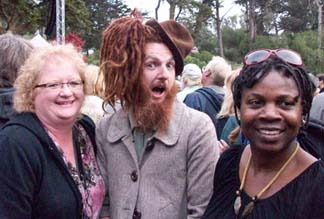 The
musicians clearly enjoyed being part of this phenomenal festival. Some
sat in to play as guest artists, even if they were not scheduled to do
so. One of those instances was when The Punch Brothers played with Elvis
Costello and Steve Earle. Sometimes they just stood backstage to simply
appreciate each other’s performances. Highlight acts included festival
founder Warren Hellman himself playing the banjo and Steve Martin, the
actor, who played banjo with his band, the Steep Canyon Rangers.
The
musicians clearly enjoyed being part of this phenomenal festival. Some
sat in to play as guest artists, even if they were not scheduled to do
so. One of those instances was when The Punch Brothers played with Elvis
Costello and Steve Earle. Sometimes they just stood backstage to simply
appreciate each other’s performances. Highlight acts included festival
founder Warren Hellman himself playing the banjo and Steve Martin, the
actor, who played banjo with his band, the Steep Canyon Rangers.
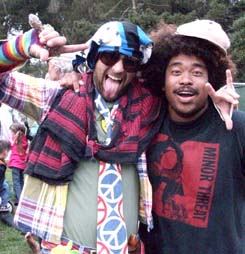
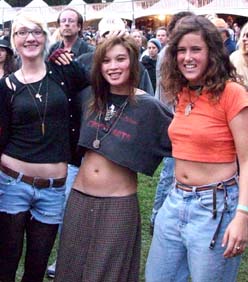
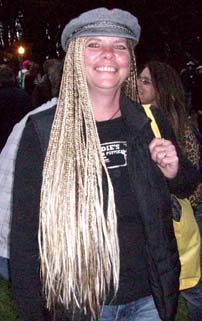
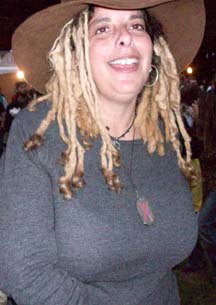
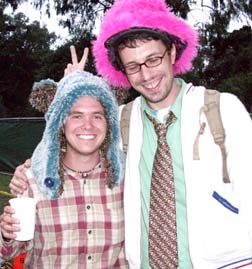
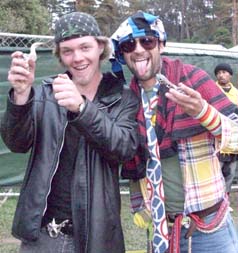
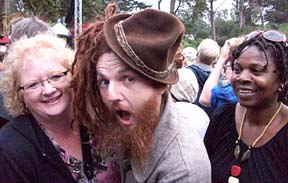
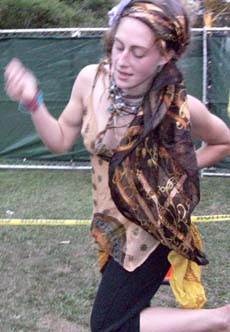
![Trumpeter Wayne Bergeron in October 2009, as he briefly played with the NJO. [Photo by Tom Ineck]](media/1010Bergeron1.jpg) LINCOLN,
Neb.—When trumpet great Wayne Bergeron appeared with the Nebraska Jazz
Orchestra a year ago, he was sidelined by a serious lip injury that
required the help of a capable young protégé who traveled with him. On
Bergeron’s return for an Oct. 15 performance with the NJO at the Lied
Center for Performing Arts, no one in the audience of 600 could have
doubted that he had fully recovered his embouchure, a trumpeter’s most
valued possession.
LINCOLN,
Neb.—When trumpet great Wayne Bergeron appeared with the Nebraska Jazz
Orchestra a year ago, he was sidelined by a serious lip injury that
required the help of a capable young protégé who traveled with him. On
Bergeron’s return for an Oct. 15 performance with the NJO at the Lied
Center for Performing Arts, no one in the audience of 600 could have
doubted that he had fully recovered his embouchure, a trumpeter’s most
valued possession.![Wayne Bergeron [Courtesy Photo]](media/1010Bergeron2.jpg) the
evening, a complex, rocking arrangement of “Besame Mucho” in which the
ensemble excelled with great facility as it kept pace with Bergeron.
the
evening, a complex, rocking arrangement of “Besame Mucho” in which the
ensemble excelled with great facility as it kept pace with Bergeron.
![The Valerie Capers Quintet at Doane College [Photo by Tom Ineck]](media/1010Capers4.jpg) 2003.
The latest performance had all the hallmarks of the band’s typical,
well-rehearsed repertoire—with one unfortunate exception. Still capable
of holding her audience spellbound with her dazzling piano technique,
Capers was suffering from a bad case of laryngitis and was barely able
to speak, let alone sing. When in good health, she has a voice
reminiscent of Shirley Horn or Ella Fitzgerald in her later years, and
she sings in French and Portuguese as convincingly as English.
2003.
The latest performance had all the hallmarks of the band’s typical,
well-rehearsed repertoire—with one unfortunate exception. Still capable
of holding her audience spellbound with her dazzling piano technique,
Capers was suffering from a bad case of laryngitis and was barely able
to speak, let alone sing. When in good health, she has a voice
reminiscent of Shirley Horn or Ella Fitzgerald in her later years, and
she sings in French and Portuguese as convincingly as English.![Suffering from laryngitis, Capers spoke briefly from Braille notes. [Photo by Tom Ineck]](media/1010Capers1.jpg) guitarist
Mark Marino, bassist John Robinson and drummer Earl “Boom Boom”
Williams. They all were in top form on Oct. 9 at Heckman Auditorium.
guitarist
Mark Marino, bassist John Robinson and drummer Earl “Boom Boom”
Williams. They all were in top form on Oct. 9 at Heckman Auditorium.![Alan Givens plays soprano with urgency on "Caravan." [Photo by Tom Ineck]](media/1010Capers2.jpg) remained
apolitical. By way of introduction, Capers, who is blind, read (in
Braille) of the 1963 bombing of a Baptist church in Alabama that
resulted in the deaths of four young girls. Coltrane was inspired by the
incident to write his profoundly moving “Alabama,” and the Capers
ensemble did it justice, beginning with a solemn and powerful opening
statement by Givens on tenor, followed by a mournful bowed bass solo,
Capers’ gospel-flavored piano and a guitar solo that segued back to
Givens on tenor. It was a stunning performance.
remained
apolitical. By way of introduction, Capers, who is blind, read (in
Braille) of the 1963 bombing of a Baptist church in Alabama that
resulted in the deaths of four young girls. Coltrane was inspired by the
incident to write his profoundly moving “Alabama,” and the Capers
ensemble did it justice, beginning with a solemn and powerful opening
statement by Givens on tenor, followed by a mournful bowed bass solo,
Capers’ gospel-flavored piano and a guitar solo that segued back to
Givens on tenor. It was a stunning performance.![Givens on flute and Robinson on sopranino recorder [Photo by Tom Ineck]](media/1010Capers3.jpg) tom
toms, picking up the pace for Capers’ dazzling, fleet-fingered piano
solo. Marino on guitar and Givens on soprano sax added to the urgency of
the performance and brought the first set to a raucous close.
tom
toms, picking up the pace for Capers’ dazzling, fleet-fingered piano
solo. Marino on guitar and Givens on soprano sax added to the urgency of
the performance and brought the first set to a raucous close.![Capers Quintet takes the stage for a final bow. [Photo by Tom Ineck]](media/1010Capers5.jpg) hour
concert and act as a showcase for the entire band. Givens gave the tune
a mellifluous samba feel on tenor sax, then switched to flute for a
saucy salsa beat. Marino again demonstrated his fret board skills with
climbing octaves, Capers added a very percussive piano solo, Robinson
bowed the bass with great precision and Williams laid into the drum kit
with fervor.
hour
concert and act as a showcase for the entire band. Givens gave the tune
a mellifluous samba feel on tenor sax, then switched to flute for a
saucy salsa beat. Marino again demonstrated his fret board skills with
climbing octaves, Capers added a very percussive piano solo, Robinson
bowed the bass with great precision and Williams laid into the drum kit
with fervor.
![Saxophonist Curt McKean and trumpeter Doyle Tipler [Photo by Jesse Starita]](media/1010Luigi2.jpg) encounter
with Luigi Waites, the late Omaha jazz
legend and subject of the Aug. 12 evening
tribute concert.
encounter
with Luigi Waites, the late Omaha jazz
legend and subject of the Aug. 12 evening
tribute concert.![High-rise condos encircle Turner Park and help shield concert-goers from sun. [Photo by Jesse Starita]](media/1010Luigi3.jpg) attended
the
six Jazz on the Green concerts at
Midtown Crossing—its first year taking
over hosting duties after Joslyn’s
illustrious 25-year run. Three high-rise
condominiums encircle the park’s west
side and, more importantly for
spectators, help suppress the ferocious
heat of an August sun. And a large
elliptical lawn smoothly slopes downward
to the stage, so finding a bad seat
takes effort.
attended
the
six Jazz on the Green concerts at
Midtown Crossing—its first year taking
over hosting duties after Joslyn’s
illustrious 25-year run. Three high-rise
condominiums encircle the park’s west
side and, more importantly for
spectators, help suppress the ferocious
heat of an August sun. And a large
elliptical lawn smoothly slopes downward
to the stage, so finding a bad seat
takes effort. ![Bassist Steve Gomez [Photo by Jesse Starita]](media/1010Luigi4.jpg) introduction
to “Fuse This,” a playful, irreverent
cut from Luigi Inc.’s debut CD, released
earlier this year. Tipler, saxophonist
Curt McKean, guitarist Jeff Scheffler,
bassist Steve Gomez and drummer Steve
Knight forge Luigi Inc., owning a sound
that’s molded in Luigi’s spirit, but not
beholden to it. Throughout the evening,
the quintet displayed a striking ability
to deliver originals, like Scheffler’s
Latin-dipped “New England Suite,” and
standards, such as a pensive
interpretation of Wayne Shorter’s
“Footprints,” with equal care and
nuance.
introduction
to “Fuse This,” a playful, irreverent
cut from Luigi Inc.’s debut CD, released
earlier this year. Tipler, saxophonist
Curt McKean, guitarist Jeff Scheffler,
bassist Steve Gomez and drummer Steve
Knight forge Luigi Inc., owning a sound
that’s molded in Luigi’s spirit, but not
beholden to it. Throughout the evening,
the quintet displayed a striking ability
to deliver originals, like Scheffler’s
Latin-dipped “New England Suite,” and
standards, such as a pensive
interpretation of Wayne Shorter’s
“Footprints,” with equal care and
nuance.![Concert-goers dance and play in front of stage. [Photo by Jesse Starita]](media/1010Luigi1.jpg) Thomson’s
serenely punctuated guitar solo on “On
Green Dolphin Street” were
two admirable examples.
Thomson’s
serenely punctuated guitar solo on “On
Green Dolphin Street” were
two admirable examples.
![Midtown Crossing draws 7,000 for Jazz on the Green [Photo by Jesse Starita]](media/1010Sanchez1.jpg) OMAHA,
Neb.—Less than
two months ago, a covey of Omaha
luminaries convened at 33rd
and Farnam streets to snip the red tape
on a wondrous feat of urban planning.
After years of building its cosmopolitan
profile, the city unveiled its latest
effort—Midtown Crossing, a 15-acre
mosaic of Somali community centers,
Mexican taquerias and Polish sausage
lunchrooms. Inside the crossing, three
soaring tan apartments, replete with
coffee shops, bars and art galleries, encircle a verdant
elliptical green space. Jazz and leisure
would be hard pressed to find a more
comforting host. So, on an unusually
cool July 8 evening, an estimated crowd of
7,000 gathered to inaugurate the 2010
Jazz on the Green Series and to welcome
Poncho Sanchez to the neighborhood.
OMAHA,
Neb.—Less than
two months ago, a covey of Omaha
luminaries convened at 33rd
and Farnam streets to snip the red tape
on a wondrous feat of urban planning.
After years of building its cosmopolitan
profile, the city unveiled its latest
effort—Midtown Crossing, a 15-acre
mosaic of Somali community centers,
Mexican taquerias and Polish sausage
lunchrooms. Inside the crossing, three
soaring tan apartments, replete with
coffee shops, bars and art galleries, encircle a verdant
elliptical green space. Jazz and leisure
would be hard pressed to find a more
comforting host. So, on an unusually
cool July 8 evening, an estimated crowd of
7,000 gathered to inaugurate the 2010
Jazz on the Green Series and to welcome
Poncho Sanchez to the neighborhood. ![People dance to the infectious beats of Poncho Sanchez. [Photo by Jesse Starita]](media/1010Sanchez2.jpg) As
a conga player and bandleader for four
decades, Poncho was not in unfamiliar
territory. Over those decades, the
Laredo, Texas, native has fused a
part-Wilson Pickett, part-Tito Puente
sound that strikes a universal appeal.
His eight-member group, with whom he
recorded his latest release “Psychedelic
Blues,” is sharp and experienced, with
role-players who can share the limelight
when called upon. Beneath a cloudless
sky stretched far above Farnam Street,
Poncho carved out the opening notes of
Rudy Toombs’ “One Mint Julep.” A
ponderous version of Jerome Kern’s
“Yesterdays” followed, camouflaging the
rhythm-bonanza that would ensue. Around
the grounds, ostentatious new pubs
advertised fancy cocktails and gourmet
burgers, children hula-hooped and
families lounged on cotton blankets;
Cuban brass and the sounds of a gentle
summer evening melted together in the
open air.
As
a conga player and bandleader for four
decades, Poncho was not in unfamiliar
territory. Over those decades, the
Laredo, Texas, native has fused a
part-Wilson Pickett, part-Tito Puente
sound that strikes a universal appeal.
His eight-member group, with whom he
recorded his latest release “Psychedelic
Blues,” is sharp and experienced, with
role-players who can share the limelight
when called upon. Beneath a cloudless
sky stretched far above Farnam Street,
Poncho carved out the opening notes of
Rudy Toombs’ “One Mint Julep.” A
ponderous version of Jerome Kern’s
“Yesterdays” followed, camouflaging the
rhythm-bonanza that would ensue. Around
the grounds, ostentatious new pubs
advertised fancy cocktails and gourmet
burgers, children hula-hooped and
families lounged on cotton blankets;
Cuban brass and the sounds of a gentle
summer evening melted together in the
open air.![Poncho Sanchez on congas [Photo by Jesse Starita]](media/1010Sanchez3.jpg) Lest
things got too comfortable, on the
“Willie Bobo Medley,” Sanchez exhorted
Omaha to “get up and salsa!” His
hands taped like a heavyweight prize
fighter, Sanchez lured his congas into a
remarkable rhythmic range: a delicate
pat, several thunderous wallops, a
series of intricate hide spankings,
and—when that pattern ran dry—he
repeated, faster or slower. Unlike
drums, guitar or saxophone, which allows
musicians to dip into a reservoir of
pyrotechnics, congas are no frills. Yet
Poncho summons a wide range of emotion,
from warm empathy to impulsive throb.
Fittingly, after a few Stax-inspired
numbers, including Wilson Pickett’s
“Funky Broadway,” the opening set
concluded with a lavish Cuban salsa,
ending with a quiet exchange between
Poncho’s weathered mitts (imagine your
hands after 40 years of conga playing)
and equally weathered rawhide.
Lest
things got too comfortable, on the
“Willie Bobo Medley,” Sanchez exhorted
Omaha to “get up and salsa!” His
hands taped like a heavyweight prize
fighter, Sanchez lured his congas into a
remarkable rhythmic range: a delicate
pat, several thunderous wallops, a
series of intricate hide spankings,
and—when that pattern ran dry—he
repeated, faster or slower. Unlike
drums, guitar or saxophone, which allows
musicians to dip into a reservoir of
pyrotechnics, congas are no frills. Yet
Poncho summons a wide range of emotion,
from warm empathy to impulsive throb.
Fittingly, after a few Stax-inspired
numbers, including Wilson Pickett’s
“Funky Broadway,” the opening set
concluded with a lavish Cuban salsa,
ending with a quiet exchange between
Poncho’s weathered mitts (imagine your
hands after 40 years of conga playing)
and equally weathered rawhide.